Reports and studies are commissioned and completed every day within Congress and the Department of Defense with the most infamous ones like the annual National Defense Authorization Act utilizing whole pallets of paper by themselves. These more well-known reports are well known because of their sweeping consequences – the potential to erase entire military installations off the map for example, in the case of a Base Realignment and Closure commission. But smaller, more mundane reports can also carry weight and consequences for military installations and the communities they reside in. The most recently published Marine Corps’ “Installations and Logistics 2030” is certainly one of those reports.
Installation and Logistics 2030 is one of the Corps’ four published strategic documents laying out how the Marines of the future will fight. As the Marine Times explains, “Force Design 2030, released in 2020, lays out warfighting concepts, while Training and Education 2030 and Talent Management 2030 discuss how to retain and train Marines who can put those new concepts into action”. Meanwhile, the Installations and Logistics report focuses primarily on suppling and sustaining the Marine Corps during warfighting, but also puts a large focus on improvements to infrastructure on its bases, especially housing.
It’s old news across the DoD that military housing could be better. Over the last year alone, reports have circulated about mold issues and perpetually broken air conditioning in barracks, and sewage leaks and maintenance problems in privatized communities on bases. Installations and Logistics 2030 charts a way forward to solve these problems through renovations and includes significant language on improving the resiliency of bases against other prevalent issues such as climate change.
These focus areas within Installations and Logistics 2030 should come as no surprise to those who frequent this blog or have any knowledge of Beaufort County’s Marine Corps installations. Credit should be given to those forward-thinking individuals both in and out of uniform who have made Marine Corps Recruit Depot Parris Island one of the leaders in infrastructure resilience prioritization and investment in exactly the way the report calls for. Other efforts, including those by local elected leaders (as explained by this blog earlier in the month) will do much to get in front of any base relocations that could result from the report’s task review the locations where the Marine Corps undertakes its missions across the globe.
But beyond the usual topics of resiliency, this report also points to good overall outcomes for the military communities of Beaufort County as a result of the focus on housing and installation upgrades. Housing remodels and installation improvements equate to more construction jobs across the community and better living conditions for servicemembers and their families. The end result should be efforts that raise the quality of living for not only the servicemembers at MCAS Beaufort and MCRD Parris Island, but also the entire Beaufort community as a whole.





